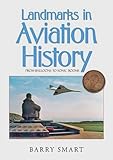| Title: | Landmarks in Aviation History: An Illustrated History of Aviation and an International Guide to Aviation Monuments All in One |
| Categories: | Construction |
| Authors: | Barry Smart |
| ISBN-10(13): | 1846830362 |
| Publisher: | Woodfield Publishing |
| Publication date: | 2008-10-01 |
| Number of pages: | 254 |
| Language: | English |
| Picture: |

|
| Review: |
This book should be attractive to readers with even only a casual interest in aviation. It is easily absorbed and not heavy on technological details. It is predominately a visual book with lots of photographs that often make the accompanying text at times almost secondary as the pictures themselves tell the main story. The tag line 'From Balloons to Sonic Booms' delineates the range of aviation landmarks covered in this book. The book's structure is chronological beginning with an overview of the earliest references to the possibility of manned flight. It is followed by the Balloon Era referring to the exploits of the Montgolfier brothers' hot air balloons and physicist J.A.C.Charles' hydrogen balloon. Britain's Sir George Cayley's work with gliders made him arguably the first aeronautical engineer. Early landmarks include references to airships and gliders and in the early 20th century the arrival of powered flight with the successes of the Wright brothers in the USA and Gabriel Voisin, Hubert Latham and Louis Bleriot in Europe. The formation of the Royal Flying Corps and the use of aircraft in World War I is well documented. The technological developments in aircraft between the two world wars allowed Alcock and Brown's crossing of the Atlantic. The developments of flying boats, autogyros and the famous Rolls Royce Merlin engine are also covered. The 1930's featured the exploits of Amy Johnson and her DeHavilland Gypsy Moth and saw the establishment of several passenger airlines using Handley-Page, Douglas and Junkers aircraft. The first steps by Sir Frank Whittle towards the jet engine was the big technological step forward. Whilst the same decade saw the coming of age of the Royal Air Force under Lord Trenchard. World War II saw the development of RADAR and the much increased use of aircraft in a military capacity. Spitfires, Hurricanes, Lancasters, Flying Fortresses and aviation feats such as the Dam Busters Raid are featured by the author. Post World War II saw the dawning of the super sonic age. Military aviation included the RAF'S triple V Force of Vulcan, Victor and Valiant bombers, all used as part of Britain's nuclear deterrent. The Harrier was a successful vertical take off and landing aircraft. Other military planes included the Jaguar, Nimrod and Hercules. Civil aviation leapt forwards with planes such as the DeHavilland Comet, Vickers Viscount, Lockheed Tristar, Boeings and Concorde. Given the authors roots in the RAF the book has an inevitable British perspective but this does not detract from its value to those with an interest in aviation. The reason for the books existence is quite simply the author's lifelong interest which grew into the passion that provided the tenacity to produce this book so that others can share his interest. The following sentence from the publishers notes does full justice to this book: 'The locations of all these landmarks are given, making this an excellent guidebook for those who wish to incorporate a visit to any of these shrines to aviation into their holiday plans.' Trevor Davies December 2009 |



